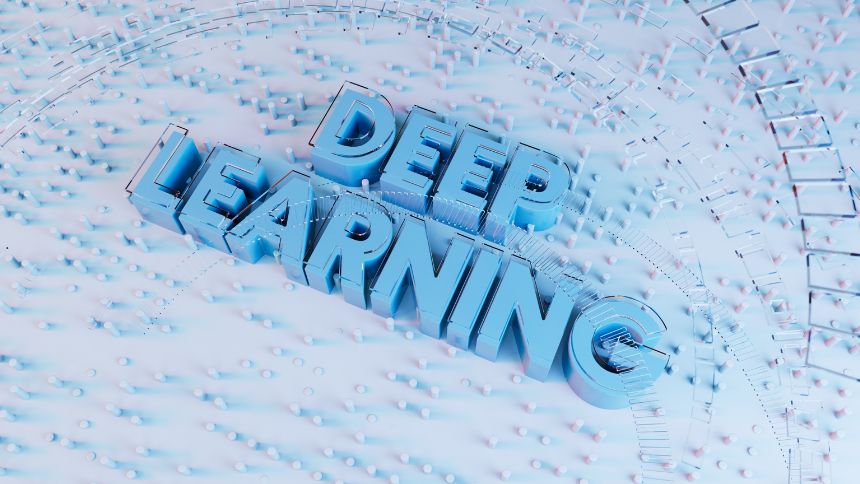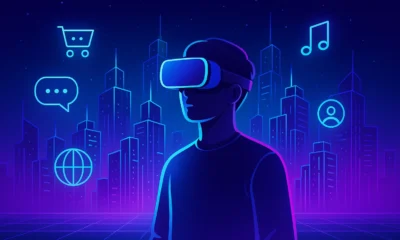Technology
7 Industries Benefiting from Deep Learning Algorithms

Deep learning is one of the most sophisticated forms of artificial intelligence (AI) which has been silently changing the world around us. From augmenting customer experiences to forecasting trends, deep learning algorithms are enabling companies to more effectively work smarter, faster and more efficiently.
Table of Contents
What Is Deep Learning ?

Deep learning is a type of artificial intelligence (AI) that teaches the computer to learn from experience, as humans do – but with the help of a lot of data and powerful machines.
Imagine showing thousands of pictures of cats and dogs on a computer. Over time, it begins to notice the pattern – for example, cats that usually have pointed ears and dogs can have a long -lasting muzzle. Eventually, the computer becomes smart enough to tell them different from themselves, even with new images it had never been seen before.
This “learning” is done through something called a neural network, which is basically a digital version of how our brains work. It’s made up of layers that take in data (like an image or voice), understand it piece by piece, and make a smart guess—such as “this is a cat” or “this is the sound of someone saying hello.”
You may not realize it, but deep learning is already part of your everyday life:
- It helps Netflix suggest movies you might like.
- It powers Google Translate when you convert a sentence to another language.
- It runs Siri and Alexa, so they understand your voice commands.
- It even helps doctors spot early signs of diseases from medical scans.
In short, deep learning helps computers get smarter on their own, so they can help us in smarter ways too.
SEO phrases: what is deep learning, deep learning explained simply, how AI learns, deep learning for beginners
How Do Deep Learning Algorithms Work?
Through multiple artificial neural network layers data travels from simpler to advanced features until completed learning occurs.
The algorithm functions according to this basic framework:
1. Input Layer – Feeding the Data
The first step involves input data which can be images or audio recordings together with textual data and numerical data in spreadsheets. The initial processing layer accepts incoming information as a next step before transferring it to the subsequent processing layer.
For example, if the input is a photo of a cat, the raw pixel values are passed into the network.
2. Hidden Layers – Learning the Features
All the processing takes place at this point. There exist multiple hidden layers which position between the initial input data and final results. The model contains multiple layers that contain neurons which serve as computational units. Neurons in these networks analyze data to detect particular patterns which include visual image edges for pictures and textual terms for sentences.
- The first hidden layer might detect simple features like curves or colors.
- The next layer combines those to detect shapes or textures.
- Deeper layers recognize complex structures—like a cat’s face.
The more layers a network has, the “deeper” it is—hence the name deep learning.
3. Weights, Biases, and Activation Functions
Each connection between neurons has a weight, which determines how much influence one neuron has on another. These weights get adjusted during training so the model gets better at making accurate predictions.
- Biases allow the model to shift the data.
- Activation functions (like ReLU or Sigmoid) help introduce non-linearity, enabling the network to solve complex problems.
4. Output Layer – Making Predictions
After processing the input through all the hidden layers, the output layer provides a result. Depending on the task, this could be:
- A label (e.g., “cat” or “dog”),
- A number (e.g., stock price prediction),
- Or a sentence (e.g., language translation).
5. Training the Model – Learning from Errors
During training, the model makes predictions and compares them to the correct answers using a loss function (a measure of error). It then uses a process called backpropagation to adjust the weights and biases to reduce that error. This loop continues over thousands (or millions) of data samples until the model becomes accurate.
7 Industries Benefiting from Deep Learning Algorithms
Let’s take a look at seven major industries that are reaping the benefits of deep learning technology, and how they’re leveraging it in real-world applications.
1. Healthcare: Enhancing Diagnosis and Patient Care
The healthcare industry is now going through a brand new change, because of deep learning. Deep learning has a key part within forecasts of illness outbreaks and within image analyses of medical things like X-rays, MRIs, and CT scans for improved care results and diagnosis precision.
Deep learning models are now able to detect early signs of cancer, diabetic retinopathy, or even Alzheimer’s far earlier than human doctors, for instance. AI-powered chatbots along with virtual health assistants are reducing the strain on healthcare workers. They are also raising patient involvement.
Key SEO phrases: deep learning in healthcare, AI for disease diagnosis, AI in medical imaging
2. Finance: Fraud Detection and Algorithmic Trading
In the fast-paced world of finance, speed along with accuracy represent what deep learning does best. To find fraudulent acts, judge credit risk, and make stock trades better, finance firms use deep learning for data analysis of large sets of data at the same time as it is happening.
Deep learning systems learn of patterns in user behavior so that they are able to flag transactions that seem unusual. This cuts down fraud losses much. To get an edge, AI tools for trading make very fast choices using current market data.
Key SEO phrases: deep learning in finance, AI for fraud detection, algorithmic trading with AI
3. Retail and E-commerce: Personalization at Scale
Have you ever noticed the strangely correct sense from items suggested on sites like Amazon or Flipkart? Deep learning is now at work. E-commerce platforms use deep learning algorithms so that they can look at browsing history and previous purchases along with search behavior for recommending likely products.
Also, AI assists retailers to handle stock as well as predict needs. AI even stops cart abandonment through retailers sending timely discounts or follow-up messages.
4. Automotive: Powering Self-Driving Cars
Deep learning technology manifests through its application within the automotive sector as one of the most visible uses of the technology. Self-driving cars function based on the continuous analysis of neural networks between sensors and cameras and radar and GPS inputs.
The neural network capability of deep learning allows vehicles to identify pedestrians together with traffic signs as well as other vehicles and obstacles on the road. Deep learning technology enables rapid, safe choices during driving operations even within complicated traffic situations. Deep learning receives substantial funding from Tesla, Waymo, and BMW because these companies aim to develop complete autonomous vehicles.
Key SEO phrases: deep learning in self-driving cars, AI in automotive industry, autonomous driving technology
5. Entertainment and Media: Smarter Content Recommendations
The deep learning systems operating within Netflix and YouTube, together with Spotify, generate recommendations of shows, videos, and songs through analyzing user preferences. The algorithms process more than just traditional user interactions because they study numerous features through thousands of signals that combine viewing patterns alongside watch duration and pause or skip actions.
Deep learning technology supports three main functions that enhance media accessibility and immersion while generating content, generating subtitles, and improving audiovisual quality.
Key SEO phrases: AI in entertainment, deep learning in content recommendation, personalized media experience
6. Manufacturing: Predictive Maintenance and Quality Control
Deep learning acceptance from manufacturers powers efficient operations that function with improved intelligence. For machine maintenance prediction and successful downtime prevention, AI systems examine industrial equipment together with production line information to anticipate equipment breakdowns.
Computer vision powered by deep learning is also being used to inspect product quality in real time, identifying defects that may be missed by human eyes.
Key SEO phrases: AI in manufacturing, deep learning for predictive maintenance, smart factory solutions
7. Education: Personalized Learning and Smart Assessment
Deep learning technology enables personalized education to develop as an educational advancement. Electronics systems for education employ artificial intelligence to create customized pathways for learning which address individual student abilities and areas where they need improvement. Adaptive learning methods of teaching make sure every student receives the support needed for their success.
The technology of deep learning enables a variety of automated systems that perform grading and deliver performance analytics as well as AI tutors that personalize the understanding of hard concepts.
Key SEO phrases: AI in education, personalized learning with deep learning, smart assessments with AI
-

 Technology6 months ago
Technology6 months agoHow to Spot Fake News Online: 10 Simple Tips to Stay Safe
-

 Automobile6 months ago
Automobile6 months ago5 Best Bikes Owned by Bollywood Stars
-

 News6 months ago
News6 months agoNirmal Kapoor, Anil Kapoor’s Mother, Passes Away at 90
-

 Lifestyle5 months ago
Lifestyle5 months agoMedha Shankar Age, Movies, and TV Shows – Full Biography of a Rising Star
-

 Technology5 months ago
Technology5 months agoBest Free Apps You Should Try
-

 Technology1 month ago
Technology1 month agoWhat is Metaverse? Simple Explanation for Beginners
-

 Technology1 week ago
Technology1 week agoHow to Use Google Pay Safely in India – Complete Beginner’s Guide
-

 Lifestyle3 days ago
Lifestyle3 days agoBest Free Learning Websites for Students


KodxDokKaf
November 3, 2025 at 2:00 pm
our website, we suggest modern and the best IT solutions through despite your establishment] kodx.uk